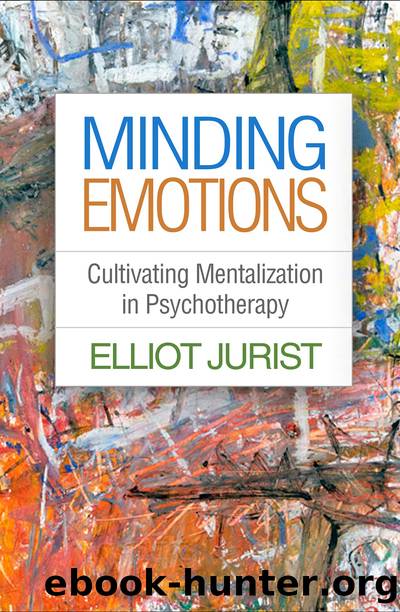Minding Emotions by Elliot Jurist

Author:Elliot Jurist [Jurist, Elliot]
Language: eng
Format: epub
ISBN: 9781462535064
Publisher: The Guilford Press
1 The idea of a âwhite relationshipâ corresponds to what we might think of as a bland relationship or a tepid transference, where affective connection appears to be weak, undeveloped, and unrecognized.
2 Green (2010) observes that Marty never defined exactly what he means by representation.
3 Some theory-theory proponents are infatuated with the analogy between the trial-and-error process of children and what scientists do (Gopnik 1993; Gopnik, Capps, & Meltzoff, 2000). This idea is controversial, however, and has been criticized as being misleading and not well developed (Bogdan, 1997; Goldman, 2006). Recently, Legare and Harris (2016) have made the intriguing proposal that the child is like an anthropologist, charged with discerning and integrating emotional and cultural learning.
4 As Carruthers and Smith (1996) describe it, âThe original false-belief task involved a character, Maxi, who places some chocolate in a particular location and then leaves the room; in his absence the chocolate is then moved to another location. The child is then asked where Maxi will look for the chocolate on his return. In order to succeed in this task, the child must understand that Maxi still thinks that the chocolate is where he left itâthe child must understand that Maxi has a false belief, in factâ (p. 2).
5 Wilkinson and Ball (2012) and Mitchell, Currie, and Ziegler (2009) argue that we should strive to move beyond viewing the two perspectives as opposing each other and seek to combine them. Bach (2011) defends a version of the hybrid account that accentuates their interrelation, based on the theory of structure mapping.
6 Lombardo, Chakrabarti, and Baron-Cohen (2009) and Heyes and Frith (2014) have also argued in favor of distinguishing between two levels of mentalization: low-level embodied/simulative representations and high-level inferences.
7 Another philosopher, Stueber (2006), has proposed a distinction between basic and reenactive empathy that closely resembles the distinction that Goldman makes between low and high mentalization. In the context of defending simulation theory, Stueber contrasts âbasic empathy,â which he sees as a fundamental perceptual level of interpersonal relations, and âreenactive empathy,â which requires a richer awareness of context and meaning. Reenactive empathy leads us not just to identify what is going on with another person, but to seek to make it intelligible.
8 MBT is currently in use in the following countries: Norway, Denmark, Sweden, Finland, Italy, Holland, Germany, Spain, Switzerland, Austria, the United Kingdom, the United States, Australia, New Zealand, Brazil, and Peru.
9 For an elaboration of the idea of âmoral injury,â see Shay (2014).
10 Fonagy and Luyten are in the process of developing a Q-sort measure of reflective function that would avoid depending on self-report in favor of therapistsâ ratings of patients.
Download
This site does not store any files on its server. We only index and link to content provided by other sites. Please contact the content providers to delete copyright contents if any and email us, we'll remove relevant links or contents immediately.
| Administration & Medicine Economics | Allied Health Professions |
| Basic Sciences | Dentistry |
| History | Medical Informatics |
| Medicine | Nursing |
| Pharmacology | Psychology |
| Research | Veterinary Medicine |
Periodization Training for Sports by Tudor Bompa(7929)
Why We Sleep: Unlocking the Power of Sleep and Dreams by Matthew Walker(6364)
Paper Towns by Green John(4807)
The Immortal Life of Henrietta Lacks by Rebecca Skloot(4264)
The Sports Rules Book by Human Kinetics(4081)
Dynamic Alignment Through Imagery by Eric Franklin(3925)
ACSM's Complete Guide to Fitness & Health by ACSM(3827)
Kaplan MCAT Organic Chemistry Review: Created for MCAT 2015 (Kaplan Test Prep) by Kaplan(3805)
Introduction to Kinesiology by Shirl J. Hoffman(3629)
Livewired by David Eagleman(3535)
The River of Consciousness by Oliver Sacks(3421)
The Death of the Heart by Elizabeth Bowen(3342)
Alchemy and Alchemists by C. J. S. Thompson(3299)
Descartes' Error by Antonio Damasio(3168)
Bad Pharma by Ben Goldacre(3105)
The Emperor of All Maladies: A Biography of Cancer by Siddhartha Mukherjee(2934)
The Gene: An Intimate History by Siddhartha Mukherjee(2929)
The Fate of Rome: Climate, Disease, and the End of an Empire (The Princeton History of the Ancient World) by Kyle Harper(2878)
Kaplan MCAT Behavioral Sciences Review: Created for MCAT 2015 (Kaplan Test Prep) by Kaplan(2823)
